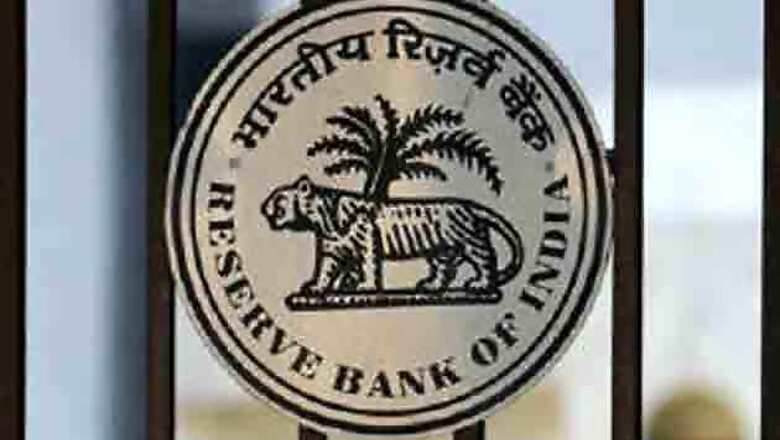
views
New Delhi: The results of the 20th round of the 'Survey of Professional Forecasters' conducted by the Reserve Bank shows a downward revision in the median growth forecast for 2012-13 to 6.5 per cent.
The industry and service sector median growth forecasts have turned low, but are expected to pick-up beginning Q2 of 2012-13. The average inflation outlook has been revised upward to 7.3 per cent for 2012-13 and moderation is expected from Q3 of 2012-13 onwards.
Overall Outlook
Inflation and macro-risks to condition growth-enabling policy actions.
Even as the growth outlook remains weak, while inflation is likely to be sticky during 2012-13. As such, inflation and macro-risks will condition growth-enabling policy actions with a view to supporting recovery in a non-inflationary manner.
The near-term outlook on inflation continues to be marked by a number of upside risks, despite the significant slowdown in growth.
Professional forecasters as well as external agencies have lowered growth projections. Surveys of business expectations confirm that confidence levels are low.
Improving the investment climate by moving quickly to address bottlenecks in infrastructure space and removing constraints on FDI are important.
Global Economic Conditions
Global growth prospects have deteriorated with growth in EDEs also slowing down.
Persistent euro area problems and weakening growth in emerging and developing economies (EDEs) will be a drag on global growth in 2012.
The deceleration in growth in the BRICS nations, which have so far been drivers of EDEs' growth, has added a new dimension to the global slowdown, making near-term recovery difficult.
Recent indications suggest that global trade flows have ebbed again after some pick-up in Q1 of 2012. This trend could persist because of tight credit conditions, adverse impact of deleveraging on trade finance and growth slowdown in EDEs.
Global financial market stress resurfaced due to the deepening crisis in the euro area, especially in Greece and Spain; the Libor fixing scandal has added to the uncertainty.
Indian Economy
Output
Risks to growth have increased; output likely to stay below potential during 2012-13
Available information suggests that slowdown has extended into Q1 of 2012-13, and output expansion in 2012-13 is likely to stay below its potential.
Newer risks to growth have arisen from slowing global trade, domestic supply constraints, bottlenecks of industrial inputs particularly with regard to coal and electricity and less-than-satisfactory monsoon so far.
Until July 27, 2012, the monsoon was deficient by 21 per cent compared with the long period average. In terms of the Reserve Bank's production weighted index, the deficiency was 24 per cent. This is likely to impact kharif crops, especially coarse cereals and pulses.
The Order Books, Inventory and Capacity Utilisation Survey show a seasonal improvement in capacity utilisation levels in Q4 of 2011-12, but the Industrial Outlook Survey indicate that capacity utilisation has declined in the subsequent quarter. These Surveys are conducted by the Reserve Bank.
Services sector growth is showing signs of decelerating in line with slowdown in industrial growth and weak global economy.
Aggregate Demand
Government needs to curtail subsidies and provide an investment stimulus.
The investment outlook remains sluggish. Investment intentions in the new projects sanctioned financial assistance moderated to `2.1 trillion in 2011-12 from `3.9 trillion in 2010-11. Corporate investment is expected to decline further during 2012-13.
Sales of private, non-financial firms moderated in Q4 of 2011-12. Along with high input cost pressures, this led to declining corporate profits.
The fiscal deficit target for 2012-13 is at a risk of being breached due to likely overshooting of subsidies and shortfall in receipts.
To address this risk, fiscal space needs to be created by curtailing subsidies and significantly boosting government capital expenditures to provide an investment stimulus to the economy, which would help crowd-in private investment.
External Sector
CAD risks and concerns about sustainability persist.
Softening of global crude oil prices and moderation of gold imports may slightly lower current account deficit (CAD) in 2012-13, but risks remain, especially with slowing global growth and trade and low price elasticity of import demand.
Services exports (net) at US$14 billion in Q1 of 2012-13, have declined by about 12 per cent year-on-year. Current indications are that software export earnings may even be lower than projected by NASSCOM.
High external debt, deterioration in the net international investment position and a moderate decline in forex reserves have weakened the resilience to external shocks.
CAD-to-GDP ratio touched an all-time high of 4.2 per cent of GDP in 2011-12. With slower growth, sustainable level of CAD has also come down to around 2.5 per cent of GDP.
Monetary and Liquidity Conditions
Monetary and liquidity conditions have eased and are not significantly impinging on growth.
A 50 bps repo rate cut, following a 125 bps CRR reduction, coupled with active open market operation purchases have significantly eased monetary and liquidity conditions during 2012-13 so far.
While the rate of deposit expansion is slow, credit growth has picked up in the current financial year in line with the indicative projection. The flow of resources from non-bank sources has also been good.
Though there has been some rise in nominal and real interest rates during 2011-12, computed real weighted average lending rates (WALR) are currently significantly lower than the pre-crisis period of 2003-04 to 2007-08 when the investment boom took place.
Financial Markets
Currency and equity markets face pressure; stress may stay with rise in leverage.
Spillovers from global financial market uncertainties and waning investor confidence amidst deteriorating macroeconomic conditions, have kept domestic currency and equity markets under pressure.
The Reserve Bank's House Price Index (HPI) show that housing prices increased further during Q4 of 2011-12 in most cities, though transaction volumes fell in many cities.
Going forward, financial stress is likely to remain with falling earnings and high leverage for non-financial firms and global uncertainties.
Price Situation
Inflation pressures persist despite weakening growth momentum.
Inflationary pressures have persisted, with significant contribution from food and energy segments. Inflation expectations also remain sticky.
Going forward, the decline in global commodity prices will provide some relief, but the gains have been partly offset by rupee depreciation.
Risks to inflation remain from unsatisfactory monsoon and increases in MSP even as growth slowdown eases demand pressures. While core inflationary pressures are currently muted, a continued rise in real wages may spill over to core inflation.
Persistence of inflation, even as growth is slowing, has emerged as a major challenge for monetary policy.


















Comments
0 comment